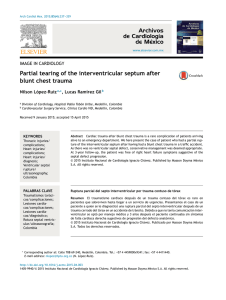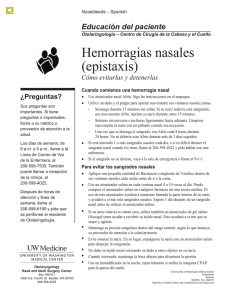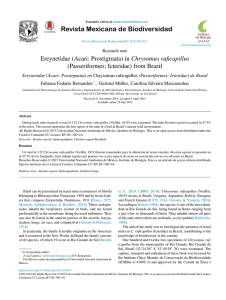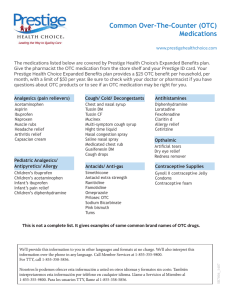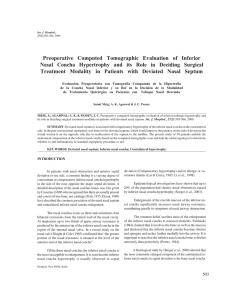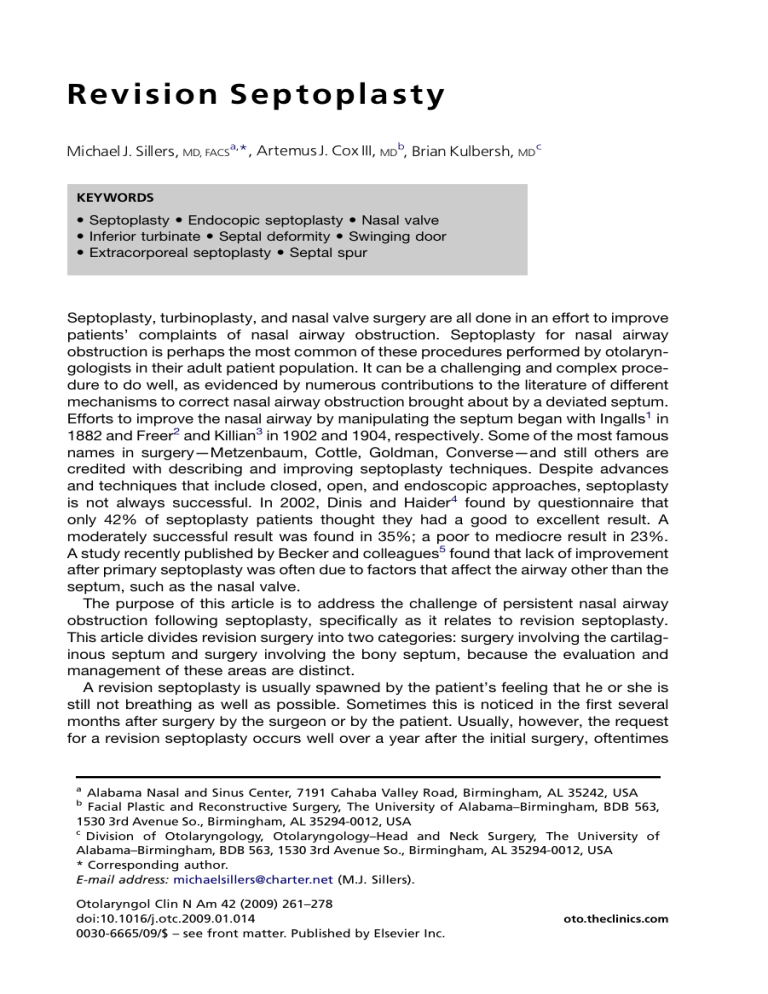
Revision Septoplasty Michael J. Sillers, MD, FACSa,*, ArtemusJ. Cox III, MDb, Brian Kulbersh, MDc KEYWORDS Septoplasty Endocopic septoplasty Nasal valve Inferior turbinate Septal deformity Swinging door Extracorporeal septoplasty Septal spur Septoplasty, turbinoplasty, and nasal valve surgery are all done in an effort to improve patients’ complaints of nasal airway obstruction. Septoplasty for nasal airway obstruction is perhaps the most common of these procedures performed by otolaryngologists in their adult patient population. It can be a challenging and complex procedure to do well, as evidenced by numerous contributions to the literature of different mechanisms to correct nasal airway obstruction brought about by a deviated septum. Efforts to improve the nasal airway by manipulating the septum began with Ingalls1 in 1882 and Freer2 and Killian3 in 1902 and 1904, respectively. Some of the most famous names in surgery—Metzenbaum, Cottle, Goldman, Converse—and still others are credited with describing and improving septoplasty techniques. Despite advances and techniques that include closed, open, and endoscopic approaches, septoplasty is not always successful. In 2002, Dinis and Haider4 found by questionnaire that only 42% of septoplasty patients thought they had a good to excellent result. A moderately successful result was found in 35%; a poor to mediocre result in 23%. A study recently published by Becker and colleagues5 found that lack of improvement after primary septoplasty was often due to factors that affect the airway other than the septum, such as the nasal valve. The purpose of this article is to address the challenge of persistent nasal airway obstruction following septoplasty, specifically as it relates to revision septoplasty. This article divides revision surgery into two categories: surgery involving the cartilaginous septum and surgery involving the bony septum, because the evaluation and management of these areas are distinct. A revision septoplasty is usually spawned by the patient’s feeling that he or she is still not breathing as well as possible. Sometimes this is noticed in the first several months after surgery by the surgeon or by the patient. Usually, however, the request for a revision septoplasty occurs well over a year after the initial surgery, oftentimes a Alabama Nasal and Sinus Center, 7191 Cahaba Valley Road, Birmingham, AL 35242, USA Facial Plastic and Reconstructive Surgery, The University of Alabama–Birmingham, BDB 563, 1530 3rd Avenue So., Birmingham, AL 35294-0012, USA c Division of Otolaryngology, Otolaryngology–Head and Neck Surgery, The University of Alabama–Birmingham, BDB 563, 1530 3rd Avenue So., Birmingham, AL 35294-0012, USA * Corresponding author. E-mail address: [email protected] (M.J. Sillers). b Otolaryngol Clin N Am 42 (2009) 261–278 doi:10.1016/j.otc.2009.01.014 0030-6665/09/$ – see front matter. Published by Elsevier Inc. oto.theclinics.com 262 Sillers et al following a period in which the patient had felt significant initial improvement in their nasal airway. Septoplasty may also unmask tension in the nose that then allows an unexpected change in appearance to occur long after the initial surgery (Fig. 1). When a patient complains of nasal obstruction following septoplasty, it is incumbent on the surgeon to determine whether this is a medical or surgical issue. Patients who have anatomic nasal obstruction may also have underlying inflammatory disease (allergic, infectious, or both) that is not being adequately treated. Revision surgery may not be effective, even when there are residual anatomic abnormalities, unless concomitant medical therapy is optimized (Fig. 2). Airflow dynamics are complicated, and air does not travel through the nose in a laminar pattern. Airflow generally occurs in an arc-wise fashion, with creation of turbulent, eddy currents that likely are responsible for the ‘‘sensation’’ of airflow. When air passes through the nasal valve (the flow-limiting anatomic region of the nasal cavity), it arcs superiorly over the anterior end of the inferior turbinate toward the head of the middle turbinate. Air passes medial and lateral to the middle turbinate and subsequently through the posterior choanae (Fig. 3).6 Therefore, evaluation of the inferior and middle turbinates and the nasal valve is essential because these structures often are additional sources of airflow obstruction. There are several means by which to objectively assess nasal volume and patency. Acoustic rhinometry and CT can give static measures of nasal volume, whereas anterior active rhinomanometry provides information on dynamic airflow. These techniques have been shown in some studies to correlate well with findings on physical examination, including nasal endoscopy, and can document improvement in objective measures following treatment, whether medical or surgical.7–11 One must exert caution, however, in the interpretation of cross-sectional minima with acoustic rhinometry, because these do not always correlate to specific anatomic structures.12 After the determination is made that anatomic nasal obstruction involving the septum exists, revision septoplasty can be considered. Fig.1. (A, B) Six months following initial septoplasty, with subsequent deviation of the nose and caudal septal deflection. Revision Septoplasty Fig. 2. (A–C) Prior septoplasty with anterior septal perforation, residual leftward septal deviation, and inferior turbinate hypertrophy. The patient has untreated allergic rhinitis. In general, there are several challenges in revision septoplasty. Patients are often frustrated and want to know why the initial surgery did not work. This question is always important to answer, as is the question of what will be done differently in a subsequent procedure. Further, a more challenging dissection in compromised tissue with an unknown amount of cartilage or bone present must be done, and done in a fashion so as not to create unanticipated external changes or a subsequent perforation. The surgeon must also accept the responsibility of exposing the patient to another anesthetic along with similar risks inherent to the initial operation. The etiology of a persistent airway blockage by the septum following an initial surgery is commonly multifactorial. Perhaps there was simply incomplete resection of the bony or cartilaginous septum that was not obvious at the time of surgery. Especially in the traumatic nose, initial resection of the septum may be adequate, but release of tension previously caused by the traumatized septum, allows another portion of the septum and possibly the external nose to reposition in a non-anatomically favorable direction (Fig. 4). Of course, there is the possibility of re-injury in a nose that is less well supported due to resection of septal cartilage and bone. Tension may also be created by inappropriate or varying planes of dissection that are noted only after healing. And, certainly, the patient’s airway complaints may have initially been due to more than simply the septal deviation and, despite a successful septoplasty, Fig. 3. Sagittal CT depicting general airflow direction through the nasal cavity; a septal spur impacts the inferior turbinate (IT). MT, middle turbinate. 263 264 Sillers et al Fig. 4. Years following nasal trauma and initial septoplasty. airway obstruction persists. This etiology is the most common reason for patient visits to the authors’ office asking for a revision. A common reason for an initially corrected septal deviation to ‘‘redeviate’’ is failure of the primary surgeon to realize that ‘‘the cartilage always wins’’ (Tom Wang, MD, personal communication, 1999). Multiple techniques have been fostered to change the shape of a curved piece of cartilage, including scoring, sutures, repositioning, and bolstering. Sometimes these techniques can work, but if the memory of the cartilage is not altered sufficiently, it often returns over time to its initial curvature and ‘‘wins.’’ Breaking this memory commonly demands a much more invasive operation, sometimes including complete autotransplantation and perhaps challenging the skill set of the general otolaryngologist. A closer analysis of the anatomy in a revision case is imperative. One must evaluate whether the septum is still a cause of airway obstruction or a cause of a change in the external appearance of the nose. The examination must include the external nose as well as the internal nose. Is the problem due to the bony or cartilaginous septum? Is the caudal septum blocking the airway in the dorsal or ventral direction and causing the tip to deviate? Is the nasal spine the culprit? Is the patient’s face simply asymmetric congenitally, creating a difference in the nostril size or position? (Fig. 5) Are there also cosmetic issues as a result of the initial septoplasty? Has the caudal septum been removed, creating tip ptosis and excessive loss of columellar show? Revision Septoplasty Fig. 5. Congenital asymmetry of facial platform resulting in nasal and septal deviation. Asking these questions and making a thorough examination, including an endoscopic evaluation, are necessary to determine whether a revision may be helpful. The surgeon must be assured that no other cause of obstruction such as polyps, turbinate hypertrophy, adenoids, concha bullosa, nasal valve, or congenital deformity exists. Or, perhaps, the decision must be made that a revision septoplasty is necessary in addition to other adjunct procedures. The quadrangular cartilage can be manipulated extensively in an effort to improve the nasal airway initially or even in a revision case. The key elements involve maintaining support with attachment at the nasal spine and an adequate ‘‘L strut’’ caudally and dorsally. The size of the L strut can vary depending on the inherent strength of the cartilage and the weight of the nasal skin but usually needs to be 7 to 8 mm in width. SURGICAL APPROACHES TO CARTILAGINOUS SEPTAL DEFORMITY The surgical approach to revising a cartilaginous septal deformity can be performed through a ‘‘closed’’ incision (hemitransfixion, full transfixion, or Killian) or through a standard open rhinoplastic approach, accessing the septum between the medial crura of the lower lateral cartilages. Historically, techniques of moving the nasal spine and caudal septal resection, like that advocated by Peer and colleagues,13 were fairly effective at straightening the caudal septum initially. Rarely, however, were the needs of resupporting the nose accomplished, often resulting in loss of appropriate columellar show and other cosmetic deformities such as a pollybeak (Fig. 6). ‘‘Swinging Door’’ Technique Another closed technique introduced by Metzenbaum is called the ‘‘swinging door,’’ in which a caudally deviated septum is released from the nasal spine and maxillary crest, adjustments are made to any excess of cartilage along the nasal floor, and the ventral caudal septum is ‘‘swung’’ to the other side of the nasal spine and sewn into place.14 This technique can be very effective for the ventral aspect of the caudal septum but does not change the inherent twist or bow of the septum. The nasal tip may remain deviated, and again, resupporting the nasal tip must be considered in this procedure (Fig. 7). Cartilage Scoring Performed in conjunction with other techniques or separately, cartilage scoring is done to weaken the concave side of a septal deviation, to remove the inherent twist 265 266 Sillers et al Fig. 6. Caudal septal resection resulting in loss of tip support and loss of columellar show with concomitant pollybeak deformity. or bend, and to ‘‘allow’’ the cartilage to straighten. Scoring is done perpendicular to the orientation of deviation, often requiring light incisions into the cartilage in both directions and perhaps on both sides of the septum.15 This technique has found favor historically and in the literature for primary and revision septoplasty; however, rarely Fig. 7. (A) Caudal septal deflection repaired by total release of septal mucosa and swinging door technique. (B) Six months post surgery. Revision Septoplasty Fig. 8. (A) Placement of spreader grafts. (B) Spreader grafts in place. can the cartilage be weakened enough to straighten and still provide the necessary support for long-term favorable results. Open Approach Due to the limitations of the closed approaches and the generally greater complexity in revising the cartilaginous septum, the authors primarily use the open approach. Most of the revisions they see involve the caudal septum, and the authors commonly add spreader grafts (Fig. 8) or make attempts to straighten the nose, which are accomplished with greater facility by the open approach. A standard inverted V transcolumellar incision (Fig. 9) is made, and dissection to expose the upper and lower lateral cartilages is completed. The medial crura are retracted laterally, and dissection is carried down onto the caudal septal angle. Meticulous dissection ensues to ensure Fig. 9. Caudal septal deflection in preparation for open septoplasty approach with inverted V incision. 267 268 Sillers et al Fig. 10. Open approach to caudal septum with medial crura reflected laterally. exposure of the cartilage in the submucoperichondrial plane. Access to the complete dorsal and ventral aspects of the caudal septum and nasal spine is achieved (Fig. 10). When the dorsal septum is deviated or the nose is crooked, the upper lateral cartilages are separated from the septum. The mucoperichondria of both sides are dissected to release all forces of scarring and contraction. This is a tedious dissection but gives excellent visualization and often allows simultaneous repair of perforations that may have resulted from primary septoplasty. Not infrequently, total release of the mucoperichondrium also releases external forces created by previous healing or trauma, setting ‘‘free’’ the crooked cartilage to straighten automatically. Fig.11. (A–C) Six months following initial septoplasty, with new caudal septal deviation and dorsal deformity. Revision Septoplasty Fig. 12. Operative view of septal deviation. This approach also gives excellent access to placing spreader grafts, batten grafts, or both to address a commonly compromised nasal valve that was not recognized initially or was caused by weakening of the septal cartilage in the initial operation. Graduated Series of Techniques The authors’ approach for revision of the cartilaginous septum, therefore, is generally open and follows a graduated series of techniques. Any deviated portions of the quadrangular cartilage not occupying the L strut area are removed and maintained for grafting purposes. When the L strut is mildly deviated, the concave side is scored, and a straight, reinforcing graft of harvested septal cartilage is sutured across the Fig. 13. (A–C) One month postoperative view following extracorporeal septoplasty augmented with Porex extended spreader grafts. 269 270 Sillers et al Fig.14. Coronal CT depicts residual rightward deviation of the PPE bone following septoplasty. deviation to maintain the correction and add support. When scoring is not effective to break the cartilage’s ‘‘memory,’’ the deviation is divided at its maximum point of curvature and then grafted. The preferable graft is septal cartilage, but autologous rib, thin perpendicular plate of the ethmoid bone (PPE), donor rib, and Porex (Porex Corporation, Newnan, Georgia) may also be used. Porex is well tolerated so long as it is well covered, usually by adjacent cartilage, and not directly underlying skin. Extracorporeal Septoplasty A more common presentation for the authors is the patient who has a poorly supported nose and virtually no straight septal cartilage. In this case, extracorporeal septoplasty is advocated. This method involves removal of most of the septal cartilage after making careful measurements of the appropriate dorsal length and caudal Fig. 15. Endoscopic view of the right nasal cavity showing residual rightward septal deviation. IT, inferior turbinate. Revision Septoplasty Fig.16. Coronal CTshows anterior superior septal deviation in a patient undergoing sinus surgery. height. A portion of the dorsal septum at the junction of the nasal bones (keystone area) is left intact to have an area to which to sew.16 The harvested cartilage is then carved and fashioned using sutures into an adequate L strut and introduced back into the nose, securing it to the keystone area and upper lateral cartilage. The configuration is made such that the caudal strut also functions as a columellar strut and is sewn to the nasal spine in addition to the medial crus of the lower lateral cartilage for tip support. In the last few years, the authors have found that a more efficient and effective variation of this method is to maintain the dorsal strut, even when crooked. Any deviations are effectively scored and then straightened by applying bilateral ‘‘extended’’ spreader grafts, which are then sewn to an ‘‘extended’’ columellar Fig.17. Endoscopic septoplasty with incision made over residual bony deviation. LNW, lateral nasal wall. 271 272 Sillers et al Fig. 18. After revision endoscopic septoplasty, the middle turbinate (MT) can easily be seen. LNW, left nasal wall. strut. Commonly, a tip graft is then applied to tie the support units together even further. This process nicely straightens the dorsum, addresses the nasal valve, and resupports the nose adequately (Figs. 11–13). Of course, the extracorporeal approach and the authors’ modification of it are aggressive and perhaps best performed by seasoned rhinoplastic surgeons. Although these procedures involve increased potential of operative risks, including poor healing of the transcolumellar scar, slight widening of the distal third of the nose, nasal rigidity, extra surgical time, and potential loss of skin in the multirevision patient,17 they offer a definitive, effective, and long-lasting repair of difficult revision septoplasty in patients and have proved to be successful in the authors’ hands. TECHNIQUES FOR ADDRESSING RESIDUAL BONY OBSTRUCTION Deviation of the PPE bone is commonly noted in patients who have residual nasal obstruction following septoplasty (Figs. 14 and 15). This deviation perhaps arises Fig.19. Initial view of the right nasal cavity with combination cartilaginous and bony septal deformity; anterior rhinoscopy alone failed to show the posterior septal deformity. IT, inferior turbinate. Revision Septoplasty Fig. 20. After the anterior deformity was corrected, intraoperative endoscopic examination reveals a posterior vomerine spur. IT, inferior turbinate; MT, middle turbinate. from a concern of ‘‘overdisarticulating’’ the bony cartilaginous junction, which may lead to dorsal deformities when the dorsal septum is separated from the nasal bones at the keystone area. Not only does PPE bone deviation lead to nasal obstruction but it can also make access to the agger nasi region, frontal recess, and frontal sinus difficult during endoscopic sinus surgery (Figs. 16–18). Large vomerine spurs may be ‘‘missed’’ during initial septal surgery for several reasons. CTs are not routinely performed in the workup of nasal obstruction, particularly when there is no associated paranasal sinus disease. When there are more anterior cartilaginous or PPE bone deviations, vomerine spurs may be overlooked during the initial evaluation. Anterior deformities may make it difficult to pass even a flexible scope into the nose. To avoid missing a vomerine spur during initial septal surgery, nasal endoscopes are particularly helpful for assessing the nasal airway throughout the procedure, even when open rather than endoscopic septoplasty is being performed (Figs. 19–21). Various approaches have been previously discussed for addressing the cartilaginous septum, and these may be used and extended to further address bony problems Fig. 21. Endoscopic view of the right nasal cavity after completion of septoplasty; the middle turbinate (MT) is easily seen. IT, inferior turbinate. 273 274 Sillers et al Fig. 22. Endoscopic view of the initial septal flap elevation; there appears to be a cartilaginous/bony leftward deviation. when they exist in concert. When isolated bony abnormalities persist, endoscopic techniques are invaluable. Several investigators have described the indications and pitfalls of endoscopic septoplasty.18–24 A common thread is that isolated spurs and deviations, including the maxillary crest, can be successfully addressed with targeted endoscopic septoplasty, eliminating the need for broad septal flap elevation, which may be problematic after prior septal surgery, particularly if quadrangular cartilage has been resected. A secondary benefit is less septal edema, which reduces postoperative morbidity and allows for easier performance of postoperative debridement when concomitant sinus surgery is performed. The site of incision is generally chosen just anterior to the area of deviation. Infiltration with 1% lidocaine with 1:100,000 epinephrine is performed. Carefully palpating this area to ensure that there is underlying cartilage or bone is paramount. Palpation can be done with a 27-gauge needle used for injection and, when done slowly, can Fig. 23. After the bony–cartilaginous junction is disarticulated, the cartilage seems to take a more midline position, illustrating the influence of the PPE bone on the overall septal position. Revision Septoplasty Fig. 24. Superior (A) and inferior (B) cuts are made along the PPE bone with Foman scissors. Fig. 25. Ferris-Smith forceps are used to remove bone. Fig. 26. Preoperative view of the left nasal cavity; the left middle turbinate (MT) is not well visualized. LNW, left nasal wall. 275 276 Sillers et al Fig. 27. Intraoperative endoscopic view of the left nasal cavity following septoplasty; the middle turbinate (MT) is seen in its entirety. LNW, left nasal wall. Fig. 28. Tenuous flaps after prior septoplasty may become perforated during revision septoplasty. Fig. 29. Portions of the vomerine septum are replaced between the septal flaps to prevent postoperative septal perforation. Revision Septoplasty hydrodissect the initial septal flap. An incision is made with a #15 blade, and one must take care not to create a perforation at this point. After the initial flap is created, the cartilage or bone can be disarticulated to gain access to the opposite septal flap, which is subsequently elevated (Figs. 22 and 23). The disarticulation can be performed with specially fashioned septal burs on a microdebrider in the case of thick bony spurs. After the bony deviation is isolated, it can be cut and subsequently removed with Ferris-Smith forceps or smaller, sinus-type forceps when working through a limited incision (Figs. 24 and 25). When removing PPE bone, it is helpful periodically to view the nasal cavity with a 0 endoscope. In general, one should be able to see the vertical attachment of the middle turbinate to ensure that the deviation has been adequately corrected (Figs. 26 and 27). When removing vomerine spurs, the sphenoethmoid recess should be visible following resection. One must look carefully for perforations during revision septal surgery because the septal flaps may be somewhat tenuous. Replacing morselized cartilage or bone is helpful when small through-andthrough perforations exist (Figs. 28 and 29). The incision is closed with a quilting stitch. SUMMARY Revision septoplasty is much more involved than primary septoplasty but can be done effectively and efficiently. The first key is making a complete and correct diagnosis of the problem or problems and then offering a comprehensive operative plan by way of an approach that will give adequate access. A graduated plan from simple removal of additional cartilage, to swinging doors and scoring, to potential extracorporeal septoplasty, to endoscopic techniques affords the careful surgeon an opportunity to safely and effectively improve the defects in nasal form and function resulting from a persistent septal deviation. REFERENCES 1. Ingals E. Deflection of septum narium. Trans Am Laryngol Assoc 1882;4:61–9. 2. Freer PC. The Bureau of Government Laboratories for the Philippine Islands, and scientific positions under it. Science 1902;16:579–80. 3. Killian H, Meyer O, Sigel O. [Not Available]. Bruns Beitr Klin Chir 1947;176: 538–58. 4. Dinis PB, Haider H. Septoplasty: long-term evaluation of results. Am J Otol 2002; 23:85–90. 5. Becker SS, Dobratz EJ, Stowell N, et al. Revision septoplasty: review of sources of persistent nasal obstruction. Am J Rhinol 2008;22:440–4. 6. Stammberger H. Functional endoscopic sinus surgery. Philadelphia: B.C. Decker; 1991. 7. Grymer LF, Hilberg O, Elbrond O, et al. Acoustic rhinometry: evaluation of the nasal cavity with septal deviations, before and after septoplasty. Laryngoscope 1989;99:1180–7. 8. Kjaergaard T, Cvancarova M, Steinsvag SK. Does nasal obstruction mean that the nose is obstructed? Laryngoscope 2008;118:1476–81. 9. Lal D, Corey JP. Acoustic rhinometry and its uses in rhinology and diagnosis of nasal obstruction. Facial Plast Surg Clin North Am 2004;12:397–405, v. 10. Roithmann R, Cole P, Chapnik J, et al. Acoustic rhinometry in the evaluation of nasal obstruction. Laryngoscope 1995;105:275–81. 11. Szucs E, Clement PA. Acoustic rhinometry and rhinomanometry in the evaluation of nasal patency of patients with nasal septal deviation. Am J Rhinol 1998;12:345–52. 277 278 Sillers et al 12. Cankurtaran M, Celik H, Coskun M, et al. Acoustic rhinometry in healthy humans: accuracy of area estimates and ability to quantify certain anatomic structures in the nasal cavity. Ann Otol Rhinol Laryngol 2007;116:906–16. 13. Peer LA, Walker JC, Van Duyn J. Progress in otolaryngology. Summaries of the bibliographic material available in the field of otolaryngology for 1947 and 1948: plastic surgery. AMA Arch Otolaryngol 1950;52:964–92. 14. Dyer WK, Kang J. Correction of severe caudal deflections with a cartilage ‘‘plating’’ rigid fixation graft. Arch Otolaryngol Head Neck Surg 2000;126:973–8. 15. Sedwick JD, Lopez AB, Gajewski BJ, et al. Caudal septoplasty for treatment of septal deviation: aesthetic and functional correction of the nasal base. Arch Facial Plast Surg 2005;7:158–62. 16. Most SP. Anterior septal reconstruction: outcomes after a modified extracorporeal septoplasty technique. Arch Facial Plast Surg 2006;8:202–7. 17. Gubisch W. Extracorporeal septoplasty for the markedly deviated septum. Arch Facial Plast Surg 2005;7:218–26. 18. Castelnuovo P, Pagella F, Cerniglia M, et al. Endoscopic limited septoplasty in combination with sinonasal surgery. Facial Plast Surg 1999;15:303–7. 19. Chung BJ, Batra PS, Citardi MJ, et al. Endoscopic septoplasty: revisitation of the technique, indications, and outcomes. Am J Rhinol 2007;21:307–11. 20. Dolan RW. Endoscopic septoplasty. Facial Plast Surg 2004;20:217–21. 21. Getz AE, Hwang PH. Endoscopic septoplasty. Curr Opin Otolaryngol Head Neck Surg 2008;16:26–31. 22. Hwang PH, McLaughlin RB, Lanza DC, et al. Endoscopic septoplasty: indications, technique, and results. Otolaryngol Head Neck Surg 1999;120:678–82. 23. Raynor EM. Powered endoscopic septoplasty for septal deviation and isolated spurs. Arch Facial Plast Surg 2005;7:410–2. 24. Sousa A, Iniciarte L, Levine H. Powered endoscopic nasal septal surgery. Acta Med Port 2005;18:249–55.
